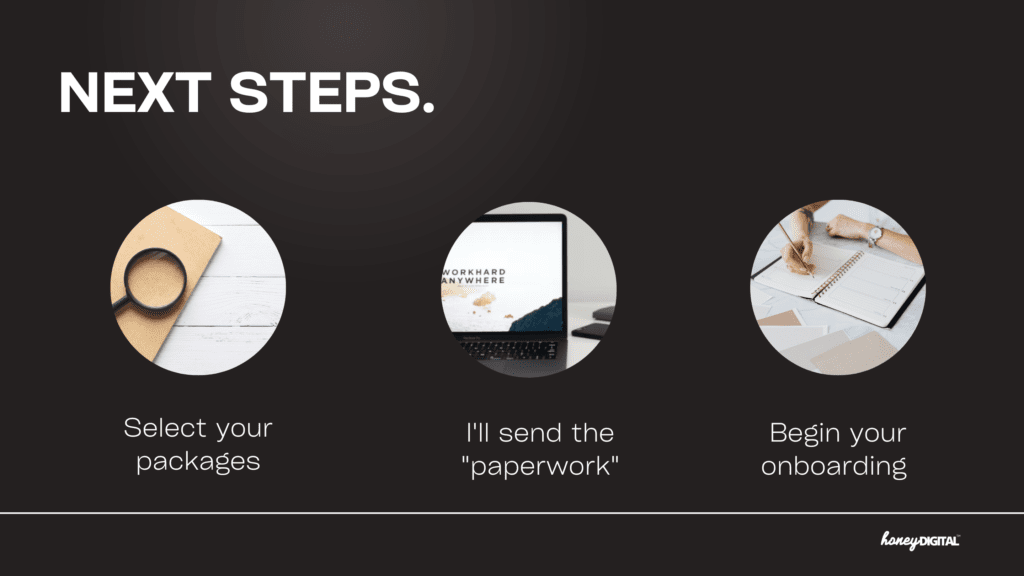How To Write A Copywriting Proposal (Free Template)
Learn how to write a copywriting proposal that gets a “yes” from clients.
The secret to booking clients is following up your discovery calls with a strong proposal.
In this post, I’ll walk you through exactly how to write a copywriting proposal so that your prospects choose you over anybody else.
You’ll learn:
- What a copywriting proposal should include
- How to create a professionally designed proposal
- How to price your services and create high-end packages
- The proposal template I use to book projects for $5,000-$10,000+
Ready to create amazing proposals that clients can’t say no to? Let’s get started…
What Should A Copywriting Proposal Include?
The secret to creating a winning copywriting proposal is to build trust and establish credibility. Anyone can call themselves a copywriter, but you want to prove to clients that you’re going to deliver results.
Even if you’re a beginner, you can do this with a strong proposal. That’s what I’ll show you next…
Elements Of A Winning Copywriting Proposal
There are 4 key elements of a strong copywriting proposal.
#1 A strong copywriting proposal builds trust
You can build trust by talking about your process, sharing testimonials, and restating the pain points and goals your client talked about on the discovery call.
(That last point is key, because it shows you understand what they need out of the project!)
#2 A strong copywriting proposal establishes your credibility as an expert
Talking about your process and sharing testimonials not only builds trust with potential clients, but it also establishes your credibility.
If you don’t have testimonials to share, you can add value by going more in detail on your copywriting process (which should include research).
Also, make your discovery calls and proposals packed with value! Be generous about sharing what you know so clients can walk away with tangible advice they can implement into their business.
#3 A strong copywriting proposal is on-brand
If clients are investing money in your services, they need to see that you also invest in yourself. You might not be design-savvy, but you still want to make sure that your copywriting proposal matches the rest of your brand.
(I’ll share more tips on how to do this later in this post.)
#4 A strong copywriting proposal shows value
Potential clients need to see that your work is going to solve a problem for them and produce results.
Always remember that your client is not paying you for copy, they’re paying you for the results that your copy will get them (i.e. more conversions).
How To Structure Your Copywriting Proposal [Free Proposal Template]
If you’re looking for a proven copywriting proposal template that you can replicate in your business, here is the one I use in my agency.
This is meant to be a foundation, so you can adjust it according to your needs
Section 1: The Introduction
If your potential client has a team, they might not be familiar with you or what you do. That’s why you want to Introduce yourself and your services, but keep this short and to the point.
This section can also include a short summary of the entire project and what you’re going to go over in the proposal. Think of it like a “cover letter” to your proposal.
(Again, make sure this section is short and to the point!)
Section 2: The Why
This is where you talk about the client’s needs, problems, and the reason they’re coming to you.
During your discovery call, they should’ve told you what you need to know for this section, so repeat that back to them.
Agitate the client’s pain points, and remind them what the impact is on their business if they don’t solve their problem.
Section 3: The Solution
This is where you describe how your offer is going to solve the client’s problem. Don’t just talk about the copy as a deliverable, but talk about the transformation and how your deliverables will help them achieve the results they’re looking for.
Section 4: The Process
I breakdown this section into two parts.
The first part details the phases of the project itself, and the second part details the phases of my copywriting process.
Here’s an example of part one:

Here’s an example of part two:

You’ll notice that I don’t go in-depth into my process on the actual proposal, I just list out the basic steps.
This is because I present my proposals on video to clients, so I give more context as I’m speaking. You can use a program like Loom to do this, or schedule a virtual meeting with your client using Calendly.
I also include a link to a separate video on the proposal where I explain my copywriting process in-depth. (If you’re a Copyland student, I include this video in my course so that you can replicate it for your own clients!)
Section 5: The Cost
Many people will use the term “investment” when talking about their rates, but I have mixed feelings about this, and here’s why…
I’ve heard some business owners rant on their hatred of the term “investment.” They feel like they’re being marketed to, and they don’t like it.
Personally, I don’t like it either—so Instead of using terms like “cost” or “investment,” I just say “packages” or “rates.” (This has worked well for me, but do what works for you!)
Since I break down projects into phases, I curate packages to meet the needs of each phase.
For example, instead of quoting one big project fee of $20,000, I have smaller packages ranging from $3K-$10K that cover different aspects of the project.
Here’s an example:

This allows a client to build their own customized project based on their budget and how in-depth they want to get on their projects.
I find this works better than giving one large lump sum—but again, you can do what works best for you. This will also vary depending on how you run your business.
I can present my rates this way because of the type of packages I provide. If you’re doing a one-time project like website copy (and that’s the only service you’re giving a client), it might be better to quote an all-inclusive fee.
Section 6: Testimonials & Case Studies
I like to put testimonials and case studies right after my packages, because it reinforces why I charge a premium rate.
Instead of ending the proposal with a big number, the last thing they see are results—that’s what I want them to leave remembering.
This section is also where you can include your past projects and examples of your work.
If you’re a beginner, you may not have testimonials (and that’s ok). You can still include samples of your work.
In my copywriting course Copyland, I teach students to create their own writing samples from scratch if they’re just starting out. That’s what I recommend for you as well.
And also…
Summarize the value your potential client gets by working with you. Remind them how you’ll help get them the results they’re looking for.
Section 7: Next Steps
If a potential client wants to move forward, what’s the next step? How can they start working with you?
Make it really clear what the process is to get started, and make it easy to book with you.

How To Include Writing Samples In A Copywriting Proposal
You can make your proposal resemble a portfolio by including not only the packages and overview of the project, but your work as well.
Here’s a few ways you can do this…
#1 Link to a Google Drive folder
Include screenshots with a short description of the project and a related testimonial.
#2 Create a portfolio in Canva and link to the PDF
This is the option I use, and it worked great for me. I used the pre-made templates inside of Canva, but customized it with my own fonts and colors.
#3 Use a program like Adobe Portfolio
I haven’t personally used Adobe Portfolio, but another copywriter I know uses it and it has worked well for him because he already had an Adobe subscription.
Even if you’re a beginner, you can still create a strong portfolio by including spec pieces. What clients want to see is that you’re capable of doing the work.
Even though I have “experience,” I have booked projects ranging from $3K-$5K with clients who never even saw my work. You can win over clients by focusing on your process and results.
Pro tip: don’t overpromise and underdeliver. You always want to make sure you actually execute what you’re proposing.
(If you want to gain confidence as a copywriter and develop your skills, take my free copywriting class here.)
What Services Should I Offer As A Copywriter?
Your prospect may know exactly what they want, but in some cases they’ll come to you with a problem, without knowing what they need to fix it.
In that case, it’ll be your job to propose a package that’ll solve their problem. If you have existing packages, you can propose the packages that best suit their needs.
If you need a few ideas to share inside your copywriting proposal, I’ve listed some below to get you started.
9 Services To Offer In Your Copywriting Proposal
Consulting
For clients who don’t know where to start, offering consulting services is a great way to build trust and help them gain clarity.
I offer 60-minute intensives in my agency, and while it’s not a main offer, I do include it in my copywriting proposals as an add-on service.
Web Copy
This can include copy for landing pages, sales pages, or website copy.
Email Copy
Email copy is one of my favorite copy formats! You can create retainer packages for weekly newsletters or write email sequences for a sales funnel or new product launch.
Ads
You can niche as an ad copywriter or add it to your suite of services. This might include digital ads for social media or Google, or print ads for magazines, billboards, and etc.
Brochure copy
Brick and mortar businesses still use brochures to market their business. Think of it as a “proposal” they use to showcase their services to potential customers.
You can offer to write powerful copy to get more sales with their brochures.
CTAs
You can consider having a service that specializes in auditing the call-to-actions throughout their funnel and optimizing them.
Audits
Audits are a great entry point for new prospects. Aside from consulting, it’s another way to build trust and allow them to test the waters with a copywriter.
Headlines
It doesn’t matter how good the body copy is if the headlines are wrong. Another “micro niche” you can consider, is rewriting headlines for a client’s website, sales page, or entire funnel.
VIP days
Don’t want to spend 4-6 weeks on a project? Maybe your client needs copy done in a pinch?
You can consider offering VIP days, where the client is paying for your focused time on a project rather than the finished product.
Essentially, this works like a day rate. If you’d like to learn more about it, I touch on it inside of my definitive guide to copywriting.
How To Add Value With High-end Copywriting Packages
I shared some examples of services you can offer as a copywriter, but as you develop your business you might want to target high-end clients and create bigger packages for them.
You can do this by merging together multiple services that can help deliver a clear end result.
Here are some examples…
Copy Style Guide
This can include a full suite of services that’ll set the foundation for the client’s entire messaging strategy.
You can add options like customer interviews, a brand voice guide, fresh headlines, CTAs, team bios, a company bio, social media bios, a unique selling proposition, email outreach templates, and audience personas to name a few.
Lead Generation Package
Include everything your client needs to optimize their lead generation strategy. You can include lead magnet strategy, landing page copy, email sequences, and ad copy.
Launch Package
A launch package can include a full suite of copy services to help a client launch a product or service. This can include copy for the entire sales funnel like email copy, landing page copy, sales page copy, and ad copy. You can add planning and strategy to this package as well.
Pro tip: come up with unique, benefit driven names for your packages to increase the perceived value.
For example, instead of using a generic title like “Copy Style Guide,” name it something exciting like Acquisition Accelerator Package.
(Coming up with a unique name might take extra time, but it’s worth it if it’ll entice your leads!)
How To Set Rates For Your Copywriting Proposal
One of the biggest roadblocks I see new copywriters have is pricing their services.
(Who am I kidding, even mid-level writers struggle with this sometimes!)
If you follow my formula below, you’ll (almost never) struggle with this again:

Flat rates are my favorite way to charge for projects.
To calculate what the flat rate should be, multiply your internal hourly rate by the number of hours you expect the project to take you.
(I call it an internal hourly rate because you don’t disclose this to the client. It’s only for the purpose of calculating your project rates.)
When picking your internal hourly rate, think about your skill level, past experience, and how much you need to earn to cover your expenses.
This table will help:

If you lack experience, your internal hourly rate might start at $20-$30.
After a few projects and developing your skills, you can increase to $40-$50 per hour.
A mid-level copywriter can charge $50-$70 per hour.
More experienced copywriters can charge anywhere from $90-$300 an hour and up.
These sample rates are just guidelines, so don’t get married to them, ok? There are always exceptions to the rule.
For example, you might decide to take on a project with a big name client at a lower rate because the experience is worth it to you.
It’s your biz, so you make the rules.
One more thing to note, these rates are specifically for sales copywriting. If you offer another kind of freelance writing like content writing for blogs or creative writing for a novel, rates might differ.
How To Create A Professional Proposal
I mentioned how important it is to have a portfolio that matches your brand.
Maybe you don’t have a brand identity yet (that’s ok). Just make sure the portfolio is clean and looks professional at the very least.
Clients are not going to put your proposal under a microscope and make sure you’re using the same serif font that’s on your Instagram posts.
But they’re smart, and they’ll be able to tell if your proposal looks like a homeschool craft project.
Here are some different tools you can use to easily create a professional looking copywriting proposal.
Canva
This is what I use (as of now), and I’m happy with it.
Canva has a lot of great templates you can customize with your own fonts and colors. If you’re not design savvy, I recommend sticking as close to the original template as possible to avoid it looking “DIY.”
Creative Market
If you want to invest a little cash, you can search Creative Market for a template to work with.
And.co
And.co allows you to create invoices, get contracts signed and send invoices. It’s a more affordable alternative to Dubsado (which I’ll talk about below), however it doesn’t have some of the automation and other advanced features that service providers love about Dubsado.
Dubsado
Dubsado is a little more sophisticated and comes with a higher price tag, but as your business grows and you want to automate processes in your business, it can help you do that.
The great thing is you can buy pre-designed proposal templates to save time.
Personally I’ve used Dubsado and love it, so if you’re looking to invest a little more it’s a great option.
HoneyBook
I don’t personally use HoneyBook, but I know of other creative freelancers who do and love it. You can create beautiful copywriting proposals here, but it will take some time to adjust to the platform and set up (similar to Dubsado).
There are endless programs out there for creating copywriting proposals, so this isn’t meant to be an exhaustive list. I did want to share the top resources I’ve had experience with and are easy to use.
Conclusion On How To Write A Copywriting Proposal
I’ve shared everything you need to know on how to create a copywriting proposal that sells. Now I want to hear from you…
Let me know in the comments, which tool will you use to create your next copywriting proposal?
Canva? Dubsado? And.co?
Drop a comment and let me know what you’ll try…
You might also like:
Free Email Pitch Template (How I book clients)
100 Client Niches For Copywriters
The Definitive Guide To Copywriting (Comprehensive Guide For Beginners)







Super helpful Article 🙂 Thanks .
Glad you found it helpful 🙂